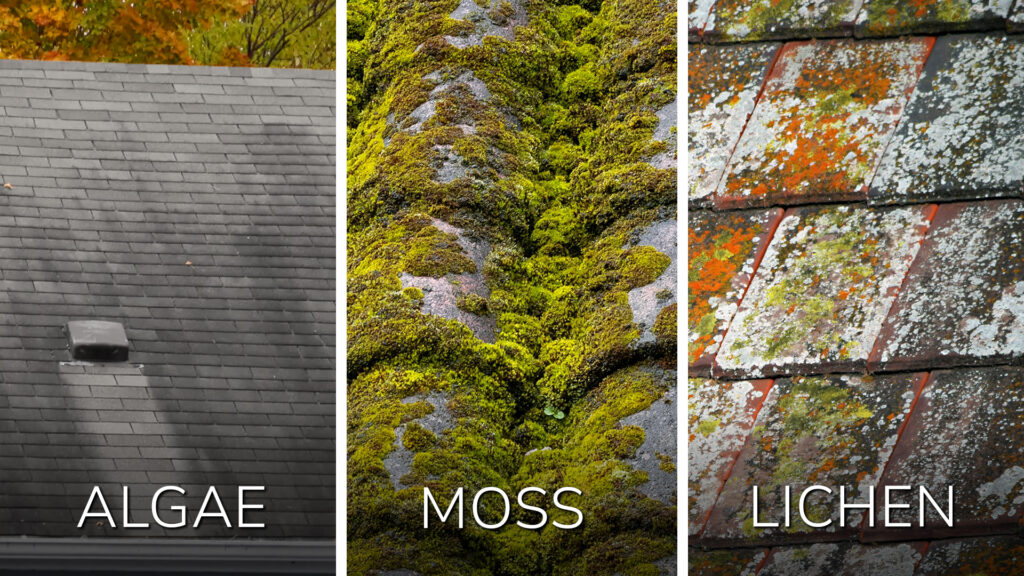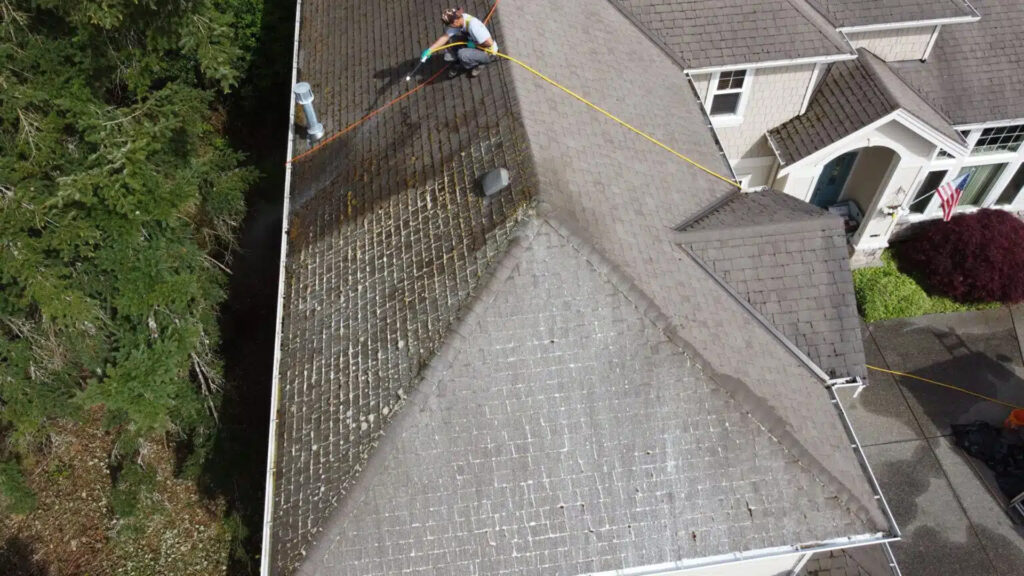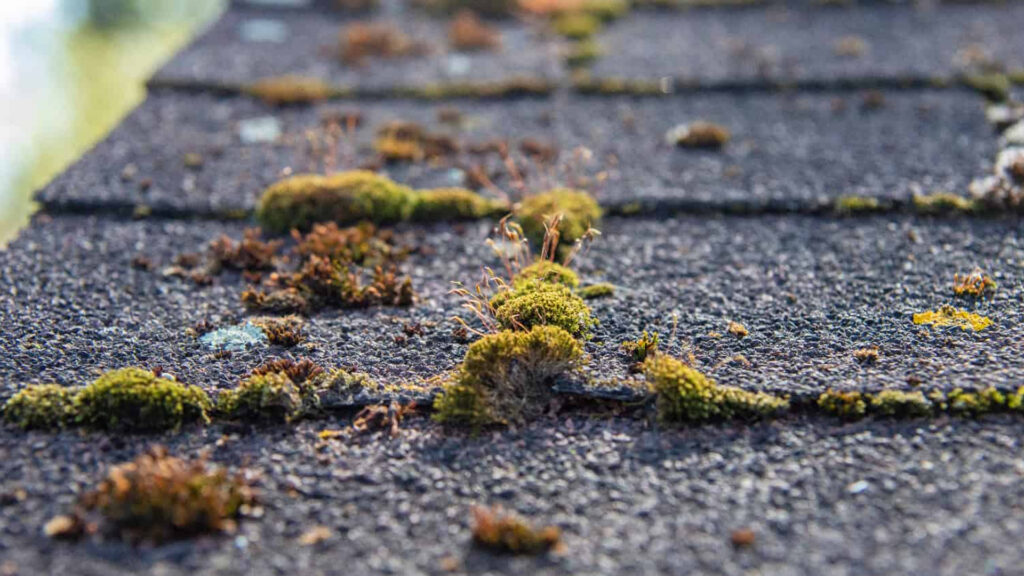Maintaining a clean roof is financially beneficial to a homeowner in several ways. The first way is that, when a roof is clean, it reflects heat. Debris on a roof actually causes it to absorb heat rather than reflect heat, so a clean roof is energy efficient. The second way is that clean roofs add to the curb appeal of a house. If you were trying to sell your house, it would be easier to sell with a clean, properly maintained roof. The third is that clean roofs prolong the lifespan of the roof. Organic growths damage the roof covering and can even damage the structure.

Let’s focus on this third point, because it’s the least apparent. It is difficult for a lot of homeowners to recognize organic growth on their roof when they see it, and many wouldn’t know what to do, if they did recognize it. Throughout this guide, we will discuss how to identify organic growth, how to safely remove it, and how to prevent it from returning.
Because organic growth is natural, many people think that it’s harmless to your roof, but that could not be further from the truth. Studies have found that organic growth can reduce the lifespan of a roof from 20-50%, depending on the region, the severity of the growth, and the maintenance practices.
Organic growth damages roof coverings and structures in the following ways:
Organic growth impedes drainage in valleys and gutters, potentially leading to pooling on the roof or blockages in the gutters and downspouts. When gutters or downspouts become clogged, they may bend, detach from the structure, or break under the pressure.
Algae’s consumption of limestone filler in asphalt shingles causes early granule loss and premature degradation of the shingles.
Granule loss that is caused either by premature degradation or as a side-effect of removing organic matter that has attached to granules, compromises the bond between the shingles and the roof and may lead to the shingles breaking down or detaching completely.
Shingles may lift as organisms grows between and under each layer. This can cause leaks and rotting of the decking and structure.
Roots from either lichen or small plants can grow into and destroy the shingles. This leads to leaks and the rotting of the decking and structure.
Acidic compounds are released during the death and decay of certain organisms or from the fecal matter of birds, squirrels, etc. These acidic compounds erode the shingles.
Moisture retention in shingles promotes the growth of a variety of organisms, accelerates the degradation of shingles, and can cause the decking or structure to rot.
Organic growth actually increases the dead load of the roof structure, which can strain older roofs and exacerbate existing problems, maybe even resulting in a collapse.
Okay, so this isn’t technically damage to the roof, but an affect of having organic growth is that the roof covering is no longer able to reflect solar rays, which causes it to absorb heat. This increased heat absorption causes warmer attic temperatures and increases the cost of cooling the house.

Many people think that keeping their roof free of debris and their gutters clean is enough, but that’s not the case. There are several things that can grow on the surface of a roof that will reduce its life expectancy. As a homeowner, you have to look for and be able to recognize these organisms: algae, moss, fungi, lichens. You may also find evidence of insects or animals, but the only way that relates to this topic is that some of the afore mentioned organisms feed off the waste of animals, and insects can live in debris on a roof. At first, these organisms can be difficult to see, but learning more about each of them will help you identify and remove them early.
The easiest way to understand these organisms is to divide them into two categories: organisms that can exist without debris, and organisms that cannot. I use this classification to help you remember which organisms can grow in which areas of the roof, so you can identify them more easily. You see, they all thrive in humid, shaded areas of the roof, but only some can be present even if you never have any debris on your roof. Before I move forward, let me clarify my use of the words shade and debris. In this guide, I use “shade” to refer to the north-facing side of the roof as well as the areas of the roof that are covered by trees. I use “debris” to refer to twigs, leaves, and dirt.
Algae, specifically Gloeocapsa magma, belongs to the first group, because it can exist without debris on the roof. Some say it feeds off the limestone filler in asphalt shingles, but that’s a little misleading, because it’s actually a type of cyanobacteria, which means it uses photosynthesis to create the energy it needs to survive. However, it does break down the calcium carbonate within the limestone filler to facilitate growth and reproduction.
This type of algae is easy to recognize. As it grows in shaded areas, it causes dark stains or streaks to appear on your roof, which is why it’s often referred to as “black algae”. The algae themselves are actually blue-green, it’s only the dead cells that form the black streaks. That doesn’t mean that you only see them when they’re dead, the dead cells form a dark protective outer layer. Interestingly, the black streaks on the roof actually indicates that the algae are thriving. The dark areas will continue to expand until the algae are killed. The good news is that when you kill the algae, you can clean the roof with a mild detergent and the dark areas will be removed, but we’ll talk about removal in the next section.
Moss and Fungus belong to the second group, because debris must be present for them to survive. They feed off organic material in debris, which as I mentioned earlier includes twigs, leaves, and the waste of animals. When there is debris on the roof, the presence of moss and fungus can be easy to miss, because the debris acts as a camouflage. However, as time passes, they will cover more surface area of the roof in black, brown, green, and/or white spots, making them easier to identify.
Lichen belongs to the second group as well, but it’s special, because it requires fungi and algae to exist. Lichen is actually a symbiosis of ascomycete fungus, basidiomycete fungus, and green alga. It’s difficult to identify at first, because they start off as very small dots and can blend in with the granules on the shingles. They become easier to identify as they cover more surface area of the roof in tough or crusty patches of green, yellow, orange, grey and/or black spots.
Regardless of the type of growth, you will need to get on top of the roof, gently brush it to remove it from the surface, and spray the roof with specially formulated liquids (not necessarily in that order). Working on top of the roof, especially with liquids, is inherently dangerous so always prioritize safety. If you are elderly or physically limited, the safest option is to hire a professional. If you are capable, your roof isn’t too steep or fragile, and you aren’t afraid of heights, then I recommend you take the following precautions:

Pressure washing the roof might sound like a good idea, because it’s quick and easy, and you won’t have to worry about chemicals. However, if your roof covering is made of asphalt shingles, you should never pressure-wash your roof. The high-pressure stream would not only remove debris and organic growth, but it would also lift or dislodge the protective granules on the shingle. The granules protect from UV rays, so once they’re gone, the shingles become more vulnerable to weathering, leaks, and premature deterioration. Also, pressure washing a roof can loosen or break shingles, leading to potential water infiltration and costly repairs. We will be looking at proper methods momentarily.

When using chemical solutions like bleach or commercial cleaners, it’s important to wear safety gear and always follow the manufacturer’s instructions. Keep in mind that there will be runoff that could affect your garden, grass, trees, and possibly even contaminate nearby water sources. First, pre-wet the ground, the trees, and the plants to add a buffer. Then cover any delicate plants with a tarp. Consider disconnecting your downspouts to collect the chemicals in buckets as they exit gutter system. Finally, after cleaning, thoroughly rinse the plants and soil with plain water to wash away any remaining residue.
Following those procedures will remove any organic growths which can significantly extend the lifespan of your roof. Now let’s look at what preventative measure you can take to prevent it the organic growth from returning.
Preventing organic growth on a roof involves a combination of regular maintenance and the addition of various roof and gutter components. Copper or Zinc strips can be installed near the ridge of the roof to help prevent organic growth. Leaf guards can be installed on gutter systems to ensure leaves and branches fall off the roof rather than collecting at gutters. Regularly trimming trees and cleaning the roof and gutters will help promote a dry, clean environment which is less susceptible to organic growth.

It’s hard to say something as general as “Make sure your roof is clean twice a year, and you shouldn’t have to worry about organic growths”, because organic growths can grow any time of the year. As we said, the primary ingredients for organic growth on roofs are moisture, shade, and organic debris, but it is often most visible during and immediately following seasons with high humidity, frequent rain, and moderate temperatures. The best advice I can give is to make sure to properly maintain your roof as needed and examine your roof at least once every four months for signs of organic growth.
You may consider having a professional roofing company apply preventative treatments containing biocides, to add an extra layer of defense. These companies may also be able to apply a roof rejuvenation treatment to your roof to help extend its life for another 5-15 years. When it is time to install your next roof covering, consider using algae resistant shingles.